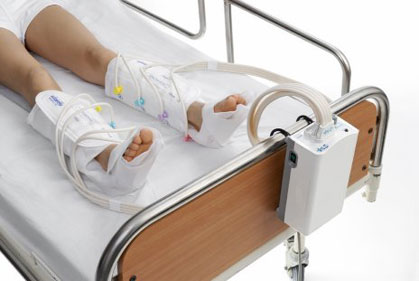A Sequential Compression Device, or SCD machine, is an electric mechanical device that helps stimulate blood movement if an individual cannot move for themselves. Whether in a healthcare center or at home, SCD machines provide extra support in preventing blood from pooling and, therefore, the future health complications usually associated with poor circulation.

History of SCD Machines
Intermittent pneumatic compression is a therapeutic technique originating in the 1950s that consists of pressurizing tissues in the body’s limbs to force fluids away from the extremities. SCD machines, which are devices considered part of intermittent pneumatic compression, began to be researched and developed in the 1970s, with the first patent for SCD machines awarded to Edward Arkans in 1980. They have been in development for over 40 years and have benefited thousands of patients to maintain their health and avoid health complications caused by reduced mobility.
Benefits of SCD Machines
SCD machines have several benefits, including:
- Reduced swelling
- Reduced pain
- Encourages circulation, blood health
- Prevents medical complications (blood clots, DVT, PE, VTE)
- Easy to use
- Transportable
- Able to be rented or purchased
How do SCD Machines Work?
SCD machines usually include a primary control unit, primarily designed sleeves that fit around a patient’s calves or calves and thighs, and a set of reusable connector tubing.
While in use, the sleeve will fit around the desired limb to be treated and connected to the primary control via the tubing. Air will be pumped directly from the control system, through the tube, and into the sleeve or jacket, which pressurizes the limb and thus forces any fluids, be it blood or lymph, up and out of the pressurized area (extremities) towards the heart to be refreshed and circulated.
Sequential compression devices work just as their name explains. The sleeve wrapped around the affected limb will have multiple pockets that can fill up with air. The part of the limb that is farthest away from the heart will receive pressure first through its respective air chamber inflating; then, the subsequent pockets will inflate, one after the other, to squeeze the blood from the underlying deep veins. After the entire sleeve has inflated with air, the sleeves will deflate, and veins will be replenished with blood once more.
This continual sequential inflation and subsequent deflation ensures the movement and replenishment of venous blood, which reduces swelling and provides pain relief.
How to Use SCD Machines
Begin by sourcing your SCD machine from a trusted and experienced medical equipment provider - this can be done through renting or purchasing. Discuss with a healthcare professional what SCD machine suits you, and consider whether to acquire a new or refurbished SCD machine.
Once you’ve received your SCD machine, unpack it and ensure all the required components are present. Consult the specialists at Medcom Group for any help setting up the device.
With the components of the device connected and the SCD machine connected to a power source, fit your limb(s) to be treated into the provided sleeve. It’s usually recommended for the skin to be bare for correct functionality.
Set the device settings as recommended by your healthcare provider, doctor, or physical therapist, and use the device accordingly regarding duration by professional guidance only.
Finally, be sure to take good care of your skin during and after the use of an SCD machine, and stop using the machine and seek medical advice should you experience:
- Swelling in your leg
- A warm area on your leg
- Pain in your leg or on the skin under the SCD machine sleeve
- A sore on the skin under the SCD machine sleeve
When Might You Need an SCD Machine?
Always follow the guidance of your healthcare professional and ask them if you have questions or think you could benefit from an SCD machine.
In general, individuals should use an SCD machine if they are at a higher risk of getting DVT, PE, VTE, and blood clots. Conditions that can increase your risk of developing one of these medical conditions include:
- Recent surgery or injuries that decrease your mobility and increase inflammation in the body, leading to clotting
- Medical conditions that limit your mobility, such as an injury or stroke
- Long periods of travel, which limit your mobility
- Injury to a deep vein
- Inherited blood disorders that increase clotting
- Pregnancy
- Cancer treatment
- Smoking
- Obesity
- Older age
The Bottom Line
SCD machines are potentially lifesaving devices. The risks of incurring severe medical challenges such as DVT, PE, VTE, and blood clots are lessened by stimulating blood movement, increasing circulation, and reducing swelling.
If you are considering acquiring an SCD machine for your healthcare practice, a carer of a bedridden loved one, or even an individual struggling with immobility yourself, don’t hesitate to contact the experts at Medcom Group today.

